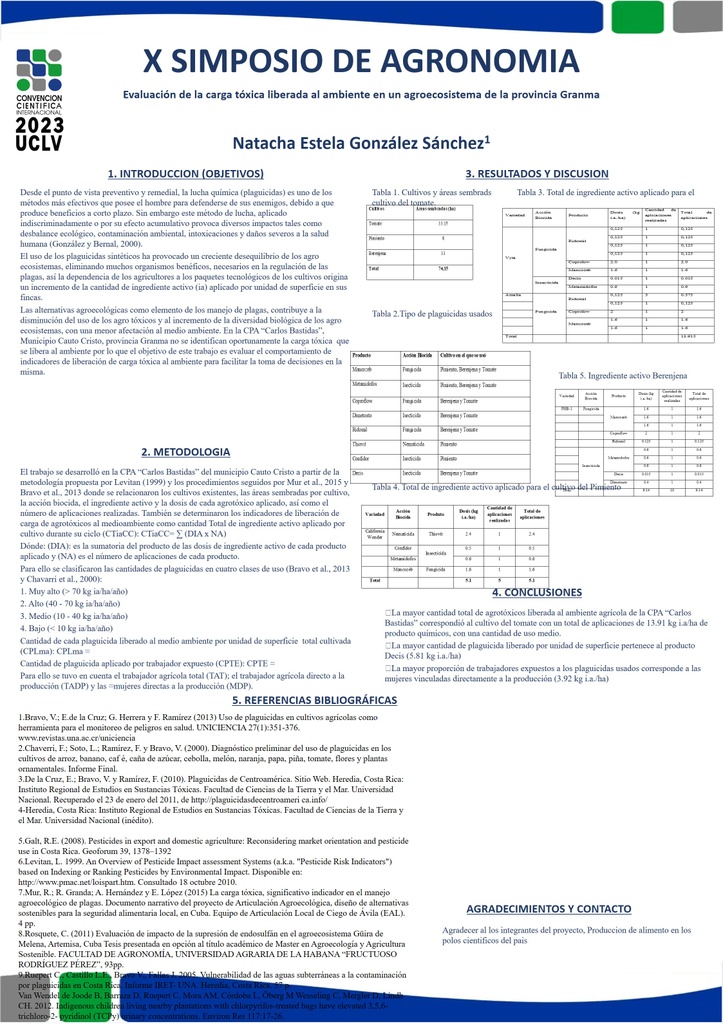Executive Secretary

9th International Scientific Conference on Agricultural Development and Sustainability
10th Symposium of Agronomy

Abstract
The research was carried out in the Carlos Bastidas CPA, Cauto Cristo municipality, Granma province, with the objective of evaluating the behavior of toxic load release indicators into the environment. The existing crops (tomato, pepper and eggplant) in planted areas, the biocide action (fungicide, incepticide and nematicide), the active ingredient (Mancozeb, Coproflow, Ridomil, Methamidophos, Dimethoate, Confidor, Decis and Thiovit), the dose were related. of each toxic agro applied, as well as the number of applications made. Indicators of the release of agro-toxic load into the environment, the Total Amount of active ingredient applied per crop during its cycle, were determined. The amounts of pesticides were classified into four classes of use (very high, high, medium and low). The Amount of pesticide released into the environment per unit of total cultivated area and the Amount of pesticide applied per exposed worker were determined. The total agricultural worker, the agricultural worker direct to production and women direct to production were taken into account. The results indicate that the largest amount of pesticide released per unit area corresponded to Decis (5.8157 kilograms of active ingredient per hectare (kg a.i./ha), Coproflow (0.6157 kg a.i./ha) and Mancozeb (0.3588 kg a.i./ha). The amount of pesticide released per exposed worker was 3.92 kg a.i.; the highest proportion corresponds to the exposure of women directly involved in production (3.27 kg a.i.) and the lowest (0.25 kgi.a.) to the total number of agricultural workers.
Resumen
La investigación se realizó en la CPA “Carlos Bastidas”, municipio Cauto Cristo, provincia Granma, con el objetivo de evaluar el comportamiento de indicadores de liberación de carga tóxica al ambiente. Se relacionaron los cultivos existentes(tomate, pimiento y berenjena) en áreas sembradas, la acción biocida(fungicida, incepticida y nematicida), el ingrediente activo(Mancozeb, Coproflow, Ridomil, Metamidofos, Dimetoato, Confidor, Decis y Thiovit), la dosis de cada agro tóxico aplicado, así como el número de aplicaciones realizadas. Se determinaron indicadores de liberación de carga de agro tóxicos al ambiente, la Cantidad Total de ingrediente activo aplicado por cultivo durante su ciclo. Se clasificaron las cantidades de plaguicidas en cuatro clases de uso (muy alto, alto, medio y bajo). Se determinó la Cantidad de plaguicida liberado al ambiente por unidad de superficie total cultivada y la Cantidad de plaguicida aplicado por trabajador expuesto. Se tuvo en cuenta el trabajador agrícola total, el trabajador agrícola directo a la producción y las mujeres directas a la producción. Los resultados indican que la mayor cantidad de plaguicida liberado por unidad de superficie correspondió a Decis (5.8157 kilogramos de ingrediente activo por hectárea( kg i.a./ha), Coproflow (0.6157 kg i.a./ha) y Mancozeb (0.3588 kg i.a./ha). La cantidad liberada de plaguicida por trabajador expuesto fue de 3.92 kg de i.a.; la mayor proporción corresponde a la exposición de mujeres directas a la producción (3,27 kg i.a.) y la menor (0.25 kgi.a.) al total de trabajadores agrícolas.
About The Speaker

Natacha Estela González Sánchez

Discussion

